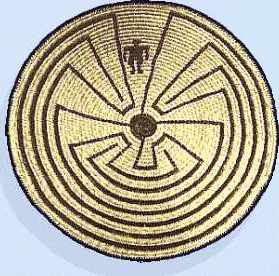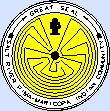 |
Native Basketry Bibliography |
|---|
|
This famous southwestern pattern -- originated by Pima-Papago (Tohono O'odham) people -- is called a "maze" basket. This name suggests ways of getting lost. But this is a lifepath basket. If you start tracing the path of the human figure at the north entrance, you will find there is one single path. That lifepath takes the person to the center-circle at each of the 4 directions: Youth (northwest), young adult (northeast), wise adult (southwest), elder age (southeast), and finally death (the south nub that closes off the path's continuation). All parts of the path are covered, it is one continuous line, representing a life lived following the Creator's instructions. All (non-Indian) writings about this pattern call it "maze." It's the opposite: a lifepath which (if followed) you cannot get lost.
| |
|---|---|
| Atkinson's Country House. Lennon, MI, is a source of many basketry supplies for the hobbyist who can't dig and process traditional plants. Free catalog. 800/832-2071 | |
| Allen, Elsie; Pomo Basketmaking: A Supreme Art for the Weaver, Naturegraph Publishers, Happy Camp, CA: 1972 | |
| American Indian Art Magazine: Special Issue on Basketry, Autumn, 1979 | |
| Angulo, Jaime de; "The Reminiscences of a Pomo Chief: The Autobiography of William Ralganal Benson," 1935. American Philosophical Society Library, Boas Collection, Philadelphia, Penn.; manuscript no. H5.3 | |
| Angulo Jaime de, and William Ralganal Benson; "Stone and Kelsy 'Massacre' on the Shores of Clear Lake in 1849: the Indian Viewpoint;" California Historical Society Quarterly, 11, No 3, (September, 1932). | |
| Bataille, Gretchen M (ed); Native American Women: A Biographical Dictionary, Garland, New York, 1993 | |
| Before the Wilderness: Enviromental Management by Native Californians, comp. and ed. T. C. Blackburn, and K. Anderson, 195-211. Ballena Press Anthropological Papers, no. 40. Menlo Park, Calif. 1993 | |
| Billy, Susan, "So the Spirit Can Move Freely," All Roads Are Good,, Smithsonian Institution Press, 1994 | |
| Blue Cloud, Peter; Alcatraz Is Not an Island, Wingbow Press, Berkely: 1972 | |
| Brown, Vinson and Douglas Andrews; The Pomo Indians of California and Their Neighbors ed. A. B. Elsasser. Healdsburg, Calif.: Naturegraph Publishers, 1969 | |
| Coe, Ralph T.; Lost and Found Traditions: Native American Art, 1965-1985, Seattle: University of Washington Press, 1986 | |
| Cohodas, Marvin, "Dat So La Lee's Basketry Design," American Indian Art, , vol 1, No. 1, Autumn (1976). | |
| Cohodas, Marvin, "The Breitholle Collection of Washo Basketry," American Indian Art, Vol 10, No 4, Autumn (1984). | |
| Cohodas, Marvin; "Dat So La Lee and the Degikup," Halcyon (1982): 119-140 | |
| Collected Documents on the Causes and Events in the Bloody Island Massacre of 1850, ed.R. F. Heizer. Berkeley: University of California Archaeological Research Facility, 1973 | |
| Collings, Jerold; "The Yokuts Gambling Tray" American Indian Art, 1, No 1, (1975). | |
| Dick, L.E. et al., Strands of Time: Yokuts, Mono and Miwok BasketmakersFresno, Calif.: Fresno Metropolitan Museum, 1988. | |
| Hirschfelder, Arlene; "Dat-so-la-lee," Artists and Craftspeople (American Indian Lives series), FactsOnFile, New York: 1994 | |
| Kroeber, Alfred; Handbook of the Indians of California, Smithsonian Press, 1925, Dover Books reprint, 1972 | |
| Lamb, Frank; Indian Baskets of North America, Riverside Museum Press, Riverside, CA, 1972 | |
| Lobb, Alan; Indian Baskets of the Northwest Coast, Graphic Arts Center Publishing Co. Portland, OR: 1978 | |
| McKee, Barbara and Edwin, Havasupai Baskets and Their Makers, 1930-40, Northland Press, Flagstaff, 1975 | |
| Ortiz, Bev; It Will Live Forever: Yosemite Indian Memories, Heyday Books, Berkeley, CA: 1991 | |
| Ortiz, Bev; Ortiz, Bev. "Baskets of Dreams;" News from Native California, vol. 2, no. 4 (1988): 28-29. | |
| Ortiz, Bev; entry on "Laura Somersal (Pomo)," in Native American Women: A Biographical Dictionary, ed. Gretchen Bataille, Garland: NY: 1991 | |
| Parrish, Otis and Paula Hammet, "Parrish: A Pomo Shaman," Native Self-Sufficiency, 6, 1981: 8-9 | |
| Porter, Frank W. (ed); The Art of Native American Basketry, Greenwood Press, New York: 1990 | Potts, Marie; The Northern Maidu, Naturegraph, Happy Camp, CA: 1977. Potts was a Maidu elder, who weavs a personal account of the history and daily lives of Maidu people into her life story. |
| Ramo, Joshua; "A Tisket, A Tasket . . . Trends: Indian Baskets are Hot Collectibles," Newsweek, December 13, 1993; 79 | |
| Robinson, Bert; The Basket Weavers of Arizona, University of New Mexico Press, Albuquerque, 1954 | |
| Russ, Julie; "Lucy Parker Telles" in Native American Women, ed. Gretchen M. Bataille, Garland, New York: 1993 | |
| Sarris, Greg; Mabel McKay: Weaving the Dream, University of California Press: Berkeley, 1994 | |
| Sawiki, Lori; "Datsolalee" in Notable Native Americans, ed. Sharon Malinowski, Gale Research, 1995 | |
| Schlick, Mary Columbia River Basketry: Gift of the Ancestors, Gift of the Earth,University of Washington Press, Seattle: 1994 | |
| Schneider, Richard C.; Crafts of the North American Indians: A Craftsman's Manual, Van Nostrand Reinhold Company, New York: 1972. Schneider was professor of Art (ceramics) at University of Wisconsin-Stevens Point, a college many Wisconsin Indians attend. He developed this book for a course where culture was learned (or relearned) both via creation of artifacts and historical-cultural studies. He shows how to make old-style tools (such as a crooked knife), how to gather and prepare materials. Clear diagrams and materials lists. Great How2 book for adult beginners. Beading, tanning and leather, ceramics, birch bark as well as splint and sewn-woven coil baskets. | |
| Siegel, Beatrice (illus. William Sauts Bock, Lenni-Lanape) ; The Basket Maker and the Spinner, Walker, 1987. YA fictionalized, using a Wampanoag girl as a focus for Eastern basketry-and-life and a fictionalized colonist woman for the contrasting spinner-woman. Illustrations are disappointing. | |
| Tanner, Clara L ; Indian Baskets of the Southwest, University of Arizona Press, Tuscon: 1983 | |
| Underhill, Ruth; Papago Woman: Biography of Maria Chona, Holt, Rinehart, Winston, New York: 1979 | |
| Wade, Edwin.; "Louisa Keyser [Dat So La Lee]" in The Arts of the North American Indian: Native Traditions in Evolution, Hudson Hill Press: New York, 1986 | |
| Whiteford, Andrew H.; "Basketry" entry in Native America in the 20th Century: An Encyclopedia, Garland: New York, 1994-96 | |
| Winther, Barbara. "Pomo Banded Baskets and Their Dau Marks."American Indian Art Magazine, vol. 10, no. 4 (1985): 50-57 | |
| Yamane, Linda (Rumsien Ohlone), photos by Dugan Aguilar; Weaving: A California Tradtion, Native American Basketmaker, A Western Mono Girl, Lerner: Minneapolis, 1997. (Middle School Social Studies: "We're Still Here" Indian series.) Very highly recommended. | Yamane, Linda (Rumsien Ohlone),drawings by Yamane; When the World Ended and Other Rumisen Oholone Stories, Oyate, Berkeley, CA,1995. |
ON LINE -- Book Sources | |
| Kashaya/Pomo bibliography on-line. | |
| Miwok bibliography on-line | |
| Yosemite bookstore with relevant Native basketry and culture books on-line | |
| Videos on California Native basketmakers for rent or sale | |
|
| |
Navigation Buttons
Page |
Menu |
MENU |
MENU |
|---|
 This is a
This is a